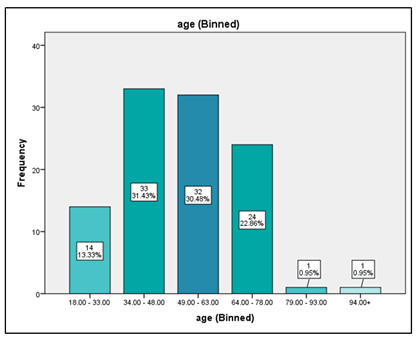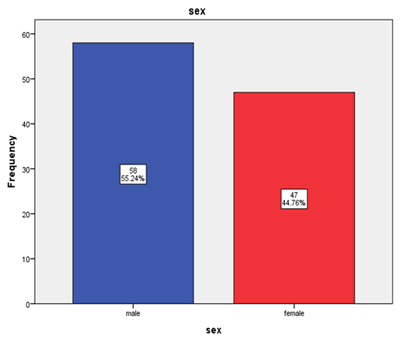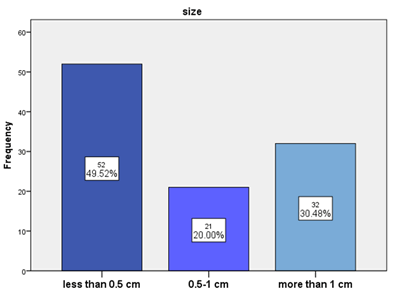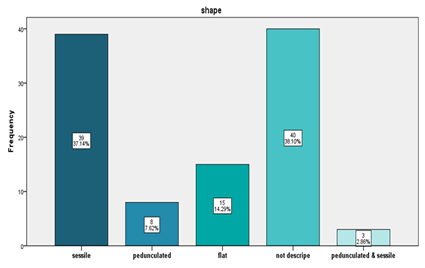Research Article - (2024) Volume 8, Issue 2
Pattern of Upper GI polyps among Sudanese Patients: A Single Centre Experience Study (Eyes Study)
Yousif Abdallah Adam*,
Esraa M Attaalmanan and
Waleed Azhary
Department of Medicine, Majmaah University, Sudan
*Correspondence:
Yousif Abdallah Adam,
Department of Medicine, Majmaah University,
Sudan,
Email:
Received: 21-Mar-2024, Manuscript No. IPJCGH-24-19279;
Editor assigned: 25-Mar-2024, Pre QC No. IPJCGH-24-19279 (PQ);
Reviewed: 08-Apr-2024, QC No. IPJCGH-24-19279;
Revised: 15-Apr-2024, Manuscript No. IPJCGH-24-19279 (R);
Published:
22-Apr-2024, DOI: 10.36648/2575-7733.8.2.12
Abstract
A gastrointestinal polyp is an abnormal protrusion from the mucosal surface of the gastrointestinal lumen and can be considered to indicate protuberant growth, which can be benign or malignant. The objectives of the present study were to evaluate the clinical features, possible risk factors, endoscopic features, and histopathological patterns of upper gastrointestinal polyps among adult Sudanese patients. Patients and methods: This was a retrospective, descriptive, cross-sectional hospital-based study. The study was conducted at the Soba University Hospital Department of Endoscopy from March 2017 to March 2020. The present study was also conducted on patients with gastrointestinal polyps found upon OGD (esophagogastroduodenoscopy). Results: We revised 2003 endoscopy reports, and 105 patients had upper GI polyps. The mean age was 51 years ± 15 years (the more affected age group was 34 years-48 years, 31.4%). Male sex was the predominant sex. The main clinical presentation was epigastric pain (40%), followed by portal hypertension (21%) (22) and anaemia and dyspep�sia (13.3%) (n14). The main site of polyps was the stomach (64%), while the duodenum and oesophagus were 21% (n22) and 13% (n14), respectively. Most polyps were small and sessile. The predominant histopathological type was inflammatory (33.3%), followed by adenomatous (10.5%) (n11) and hyperplastic (7.6%) (n7). Conclusion: From this research, we found that the frequency of upper GI polyps was 5.6%, while that of gastric pol�yps was 3.4%. The main presentation was epigastric pain. A small size >0.5 cm and a sessile shape were the dominant endoscopic features; however, inflammatory polyps were the most common type of polyp.
Keywords
Upper GI polyps; Dyspepsia; Anaemia; OGD; Fundic gland polyps
Introduction
Polyp is a Greek word for a morbid lump that may arise from any
organ, such as the gastrointestinal, respiratory, or genitourinary
tract, that contains the mucosal lumen. Gastrointestinal polyps
are abnormal protrusions from the mucosal surface of the
gastrointestinal lumen. The upper GI tract is considered to
extend to the 2nd part of the duodenum and is assessed by
OGD and colorectal polyps via colonoscopy and/or flexible
sigmoidoscopy [1].
Upper GI Polyp Classification
Gastrointestinal polyps can be classified macroscopically and/or
histologically. Polyps cannot be distinguished macroscopically
by endoscopy only due to their similar appearance. The polyps
were histologically classified as epithelial, hamartomata, or
mesenchymal. Additionally, polyps can be classified as fundic
gland polyps or hyperplastic or adenomatous polyps. Duodenal
polyps are like either gastric or colon polyps according to their
histopathological pattern [2,3].
Prevalence and Pattern of Upper GI Polyps
Oesophageal polyps are very rare. Many case reports have
discussed giant oesophageal polyps as benign neoplasms,
the prevalence of which is 0.03%. Oesophageal polyps mainly contain fibrous tissues, adipose tissues, and blood vessels,
and the major site of growth is the upper region [4]. In a
review conducted by Dr. Islam and Dr. Patel at the Mayo Clinic,
regarding gastric polyps, the authors discussed the lack of
published literature to support management and decisions for
endoscopists despite 90% of patients being asymptomatic. A
subcategory of gastric polyps requires additional intervention,
and the histological type should be considered [3]. The
importance of investigating gastric polyps was potentiated in
a meta-analysis conducted by Zhen-Jie Wue, et al., who found
a direct relationship between gastric polyps and the presence
of colorectal polyps; the incidence was greater than that in
the normal population (OR=1.15, 95% CI=1.04-1.26) [5]. In
a cross-sectional study conducted by Fu-Wei Wang, et al. in
Taiwan, more than 400 participants were asymptomatic; 29.8%
of those who underwent OGD had a mean age of 50 years-59
years; 66% of the men were affected; and 59.4%, 18.2%, and
3.5% had fundic gland, hyperplastic, and adenomatous polyps,
respectively [6]. The duodenum is a rare site of polyps in the
gastrointestinal tract. According to a review conducted by
Peter John Basford and Pradeep Bhandari, duodenal polyps are
prevalent in 0.3%-4.6% of patients who underwent gastroscopy.
Most patients are asymptomatic, and duodenal adenoma can
be partial or sporadic [7,8].
Risk Factors for Gastric Polyp
Active smoking and lack of regular exercise were found to be
the main risk factors (p=0.016, 0.009, and 0.045, respectively).
Other risk factors with fewer effects were high BMI, alcohol
consumption, excessive coffee consumption, and tea
consumption, in addition to spicy food consumption, education
level, family history of gastric cancer, and sex distribution [6].
Diagnosis of Upper GI Polyps
Most patients with upper GI polyps are asymptomatic.
Some patients may present with dyspepsia, symptoms of
UGI bleeding, and symptoms of anaemia or obstruction.
The finding of upper GI polyps remains an incidental finding.
Recently, regular endoscopy has led to a greater prevalence of
polyps; unlike for lower GI polyps, for which the macroscopic
appearance of gastric polyps is difficult to distinguish, polyp
biopsy is mandatory. Kenan Buyukasik and Mert Mahsuni
Sevinc conducted a retrospective analysis of 55,987 upper
gastrointestinal endoscopy reports, and dyspepsia was the
most common symptom (43%). The most common site was the
antrum (43.9%), the corpus (22.7%), the cardia (16.7%), the
fundus (4.54%), the second portion of the duodenum (4.54%),
the bulbous (3.03%) and the lower end of the oesophagus
(4.54%). The histopathological types of polyps included
hyperplastic polyps (66.7%), fundic gland polyps (6.06%),
squamous cell polyps (6.06%), Hematomata polyps (4.54%), and
pyloric gland adenomas (4.54%). Histopathological analysis of
the gastric mucosa revealed chronic atrophic gastritis (50.84%),
Helicobacter pylori infection (55.9%), and intestinal metaplasia
(32.20%) [9]. The prevalence of gastric polyps among anaemic
patients was studied by Alhaddad, Eric M. Ward, and others.
Over nine hindered anaemic patients underwent OGD; 14
(1.4) patients had hyperplastic polyps in the gastric antrum,
seven had multiple polyps, and nine had IDA. In conclusion,
hyperplastic polyps of the stomach with gastrointestinal blood
loss and iron deficiency anaemia should be considered [10].
Methods
This was a descriptive observational study conducted in the
endoscopy department of Soba University Hospital from March
2017 to March 2020. Soba University Hospital is considered
one of the tertiary institutions in Sudan. The endoscopy unit
at Soba Hospital is considered one of the well-equipped units
in Khartoum state, with consultant physicians and surgeons
performing the endoscopy lists.
Inclusion and Exclusion Criteria
We included all patients older than 18 years of age who were
admitted to the endoscopy unit during the study period and
who had OGDs with upper GI polyps. Patients under the
surveillance program for upper GI polyps were also included.
Our study variables included age, sex, presenting complaints,
comorbidities such as diabetes and hypertension, smoking
status, alcohol consumption, family history, regular use of
certain medications, endoscopic findings, and histopathology
reports. Along with endoscopic and histopathology reports,
data were collected via structured questionnaires via phone
calls and direct interviews. The data were analysed with the
Statistical Package for the Social Sciences (SPSS) version 24.
Qualitative data were analysed using correlation tests and
simple linear regression, and a P value less than 0.05 was
considered to indicate statistical significance. Written informed
consent was obtained from each participant, and ethical
clearance was obtained from the ethical committee of the
Sudan Medical Specialization Board.
Results
Male patients accounted for 55.2% (n=58) of the popu1lation,
while females represented 44.8% (n=47) (Figure 1). The
prevalence of upper Gastrointestinal (GI) polyps among the
Sudanese population was 5.6%. The patients selected for the
study ranged in age from 18 to 94 years, with a mean age of
51 years ± 15.8 years. The most affected age group was 34
years-48 years, comprising 31.4% of the sample (Figure 2).

Figure 1: Age distribution of patients included in the study

Figure 2: Sex distribution of patients included in the study
The main complaints were epigastric pain (40%, n=42),
anaemia (13.3%, n=14), dyspepsia (13.3%, n=14), hematemesis
(12.4%, n=13), melena (9.5%, n=10), vomiting (8.6%, n=9),
and weight loss/dysphagia (4.8%, n=5). Additionally, 21% of
patients underwent follow-up for oesophageal varices, and
5.7% underwent surveillance endoscopy (Table 1).
Table 1: Indications for OGD in patients with UGI polyps (n=105)
| Clinical Presentation |
Frequency |
Percent (%) |
| Epigastric Pain |
42 |
40 |
| Esophageal Varices |
22 |
21 |
| Dyspepsia |
14 |
13.3 |
| Anemia |
14 |
13.3 |
| Hematemesis |
13 |
12.4 |
| Melena |
10 |
9.5 |
| Vomiting |
9 |
8.6 |
| Loss of Weight |
5 |
4.8 |
| Ascites |
5 |
4.8 |
| Dysphagia |
5 |
4.8 |
| Surveillance |
6 |
5.7 |
A smoking history was reported for 11.4% of the participants
(n=12), while alcohol consumption was noted for 4.8% (n=5).
Chronic NSAID use was found in 13.3% (n=14), prolonged PPI
use was found in 8.6% (n=9), and both were found in 6.7%
(n=7). The comorbidities among patients with polyps included
diabetes alone in 3.8% (n=4), hypertension alone in 5.7% (n=6),
and both diabetes and hypertension in 6.7% (n=7). A family
history of polyps was identified in 3.8% of the patients, while
a family history of cancer was found in 10.4% of the patients
(colorectal: 2.9%, uterine: 3.8%, oesophageal: 1.9%, stomach:
1%, and combined breast and uterine: 1%). Anatomically,
oesophageal polyps accounted for 13.3% (n=14), gastric polyps
for 64% (n=68), duodenal polyps for 21% (n=22), and multiple
gastric and duodenal polyps for 1% (n=1). The polyps were
predominantly less than 0.5 cm (49.8%, n=52), with 30% (n=32)
larger than 1 cm (Figure 3). The polyp shapes included sessile
(37.1%, n=39), flat (14.3%, n=15), pedunculated (7.6%, n=8),
and 38.1% (n=40) without endoscopic description (Figure 4).

Figure 3: Differences in the sizes of UGI polyps among the study sample

Figure 4: Differences in the shape of UGI polyps among the study sample
The mucosal background was normal in 29.5% (n=31), inflamed
in 28.6% (n=30), and not described in 41.9% (n=44). Among
the 105 patients with upper GI polyps, 62% (n=65) underwent
histopathology, revealing inflammatory polyps (33.3%, n=35),
adenomatous polyps (10.5%, n=11), hyperplastic polyps (7.6%,
n=8), and fundic gland polyps (5.7%, n=6). Adenocarcinoma
was found in 1.9% (n=2) of the patients (Table 2). High-grade
dysplasia was detected in 6.7% (n=7) of the histopathology
samples, with 36% (n=4) of the adenomatous polyps exhibiting
high-grade dysplasia. No significant correlation was found
between smoking status, alcohol consumption, NSAID or PPI
use, family history of polyps or cancer, or site of polyps (P value
<0.05).
Table 2: Different histological types of UGI polyps (n=65)
| UPPER GI |
Frequency |
Percent (%) |
| Fundic gland |
6 |
5.7 |
| Hyperplastic |
8 |
7.6 |
| Adenomatous |
11 |
10.5 |
| Inflammatory |
35 |
33.3 |
| Adenocarcinoma |
2 |
1.9 |
| Oesophageal web |
1 |
1 |
| Carcinoid tumour |
1 |
1 |
| Benign lipomatous |
1 |
1 |
Discussion
To our knowledge, there are limited published data on the
prevalence and characteristics of gastric polyps in our country.
Our study, based on a review of 2003 OGD reports, revealed
an upper GI polyp prevalence of 5.6% (n=105). Gastric polyps
accounted for 3.4% (68) of the population; this figure is close
to the international rate (5%) and lower than that reported by
Wei Wang, et al. (29.8%, n=39) [6,11]. There were more males
(55.2%) than females (44.8%). These findings contrast with
those from Saudi Arabia, where females were more common
[12,13]. The mean age in our study was 51 years ± 15 years,
consistent with global trends [9,11,12].
The mean age in our study was 51 years ± 15 years, consistent
with global trends. Most upper GI polyps are incidentally
discovered during endoscopy, with epigastric pain being the
most common symptom (40%, n=42). Other symptoms included
dyspepsia (13.3%, n=14) and anaemia [9,14]. Risk factors such
as NSAID use, PPIs, smoking, alcohol consumption, family
history of polyps, cancer, DM, and HTN were not significantly
correlated with polyps (p-value <0.05) [6]. Esophageal polyps
accounted for 13.3% (n=14) of the cases, with inflammatory
polyps being the most common (33.3%). Small polyps were
prevalent (49.8%), consistent with the findings of previous
studies. In terms of histopathology, inflammatory polyps were
most common (33.3%), followed by adenomatous (10.5%) and
hyperplastic (7%). Oesophageal polyps are rare in the literature
and necessitate further investigation [14-16]. Additionally,
21% of patients with upper GI polyps were found to have
esophageal varices due to portal hypertension, reflecting the
high prevalence of portal hypertension in our country due to
schistosomal periportal fibrosis. However, further research is needed to explore the implications of these findings [17,18]
(Table 3).
Table 3: Correlations between size and type of upper GI polyp
|
Size |
Total |
| less than 0.5 cm |
0.5 cm-1 cm |
more than 1 cm |
| Histopathology |
Fundic gland |
2 |
2 |
2 |
6 |
| Hyperplastic |
1 |
2 |
5 |
8 |
| Adenomatous |
4 |
1 |
6 |
11 |
| Inflammatory |
17 |
9 |
9 |
35 |
| Adenocarcinoma |
0 |
0 |
2 |
2 |
| None |
27 |
6 |
7 |
40 |
| Oesophageal web |
0 |
1 |
0 |
1 |
| Carcinoid tumor |
0 |
0 |
1 |
1 |
| Benign lipomatous |
1 |
0 |
0 |
1 |
| Total |
52 |
21 |
32 |
105 |
| Correlations |
|
Pearson Correlation |
-.262** |
| Sig. (2-tailed) |
0.007 |
Conclusion
• The prevalence of upper GI polyps was 5.6%, with gastric
polyps accounting for 3.4%.
• Epigastric pain was the primary presentation.
• The dominant endoscopic features were small size (>0.5
cm) and a sessile shape.
• Inflammatory polyps were the most common type,
constituting 33.3% of the polyps.
Recommendation
• Upper GI polyps are not uncommon in our country;
therefore, further studies are warranted.
Limitation
The limitations of this study were that it was a single-center
study. Additional centers need to be involved in future studies.
Another limitation is the gap between the number of patients
and the histopathology samples; some of them were lost,
while others were not performed by the patients themselves.
Additionally, several reports contained missing data that
impacted our results. The correlation between GI polyps and
risk factors was difficult to determine, and case-control studies
need to be conducted in the future.
Authors Contribution
EMA, YAA, and SEM conceived the idea for the study. EMA,
YAA, and WA contributed equally to the data collection and
data analysis. EMA, YAA, and SEM contributed to the writing
and review of the manuscript. All the authors approved the
manuscript.
Acknowledgement
None.
Conflict Of Interest
The authors declare that they have no conflict of interest.
References
- Shussman N, Wexner SD (2014) Colorectal polyps and polyposis syndromes. Gastroenterol Rep (Oxf). 2(1):1-15.
[Crossref] [Google Scholar] [PubMed]
- Kenneth R, McQuaid SJM (2018) Current medical diagnosis and treatment: In current medical diagnosis and treatment. 678-679.
- Islam RS, Patel NC, Himlin DL, Nguyen CC (2013) Gastric polyps: A review of clinical, endoscopic, and histopathologic features and management decisions. Gastroenterol Hepatol (NY). 9(10):640-51.
[Google Scholar] [PubMed]
- Li J, Yu H, Pu R, Lu Z (2016) Gastroscopic removal of a giant fibrovascular polyp from the esophagus. Thorac Cancer. 7(3):363-366.
[Crossref] [Google Scholar] [PubMed]
- Wu ZJ, Lin Y, Xiao J, Wu LC, Liu JG (2014) Clinical significance of colonoscopy in patients with upper gastrointestinal polyps and neoplasms: A meta-analysis. PLoS One. 9(3):e91810.
[Crossref] [Google Scholar] [PubMed]
- Wang FW, Young SC, Chen RY, Lin KH, Chen YH, et al. (2018) The prevalence and risk factors of gastric polyp in asymptomatic patients receiving health examination. Gastroenterol Res Pract. 2018:9451905.
[Crossref] [Google Scholar] [PubMed]
- Basford PJ, Bhandari P (2012) Endoscopic management of non-ampullary duodenal polyps. Therap Adv Gastroenterol. 5(2):127-138.
[Crossref] [Google Scholar] [PubMed]
- Collins K, Ligato S (2019) Duodenal epithelial polyps: A clinicopathologic review. Arch Pathol Lab Med. 143(3):370-385.
[Crossref] [Google Scholar] [PubMed]
- Buyukasik K, Sevinc MM, Gunduz UR, Ari A, Gurbulak B, et al (2015) Upper gastrointestinal tract polyps: What do we know about them? Asian Pac J Cancer Prev. 16(7):2999-3001.
[Crossref] [Google Scholar] [PubMed]
- Haddad MA, Ward EM, Bouras EP, Raimondo M (2007) Hyperplastic polyps of the gastric antrum in patients with gastrointestinal blood loss. Dig Dis Sci. 52(1):105-109.
[Crossref] [Google Scholar] [PubMed]
- Carmack SW, Genta RM, Schuler CM, Saboorian MH (2009) The current spectrum of gastric polyps: A 1-year national study of over 120,000 patients. Am J Gastroenterol. 104(6):1524-1532.
[Crossref] [Google Scholar] [PubMed]
- Archimandritis A, Spiliadis C, Tzivras M, Vamvakousis B, Davaris P, et al. (1998) Gastric epithelial polyps: A retrospective endoscopic study of 12974 symptomatic patients. 28(7):387-390.
[Google Scholar]
- Almadi MA, Alharbi O, Azzam N, Wadera J, Sadaf N, et al. (2014) Prevalence and characteristics of colonic polyps and adenomas in 2654 colonoscopies in Saudi Arabia. Saudi J Gastroenterol. 20(3):154-161.
[Crossref] [Google Scholar] [PubMed]
- Albayrak Y (2011) Frequency of various types of gastric polyp. Cumhuriyet Tip Dergisi. 23:209-214.
[Google Scholar]
- Caceres M, Steeb G, Wilks SM, Jr HEG (2006) Large pedunculated polyps originating in the esophagus and hypopharynx. Ann Thorac Surg. 81(1):393-396.
[Crossref] [Google Scholar] [PubMed]
- Morais DJ, Yamanaka A, Zeitune JMR, Andreollo NA (2007) Gastric polyps: A retrospective analysis of 26,000 digestive endoscopies. Arq Gastroenterol. 44(1):14-17.
[Crossref] [Google Scholar] [PubMed]
- Ginsberg GG, Kawas FHAl, Fleischer DE, Reilly HF, Benjamin SB (1996) Gastric polyps: Relationship of size and histology to cancer risk. Am J Gastroenterol. 91(4):714-717.
[Google Scholar] [PubMed]
- Kara D, Kabar AH, Schmidt H, Grünewald I, Chandhok G, et al. (2018) Portal hypertensive polyposis in advanced liver cirrhosis: The unknown entity. Can J Gastroenterol Hepatol. 2018:2182784.
[Crossref] [Google Scholar] [PubMed]
Citation: Adam YA, Attaalmanan EM, Azhary W (2024) Pattern of Upper GI polyps among Sudanese Patients: A Single Centre
Experience Study (Eyes Study). J Clin Gastroenterol Hepatol. 8:12.
Copyright: © 2024 Adam YA, et al. This is an open-access article distributed under the terms of the Creative Commons Attribu�tion License, which permits unrestricted use, distribution, and reproduction in any medium, provided the original author and
source are credited.





